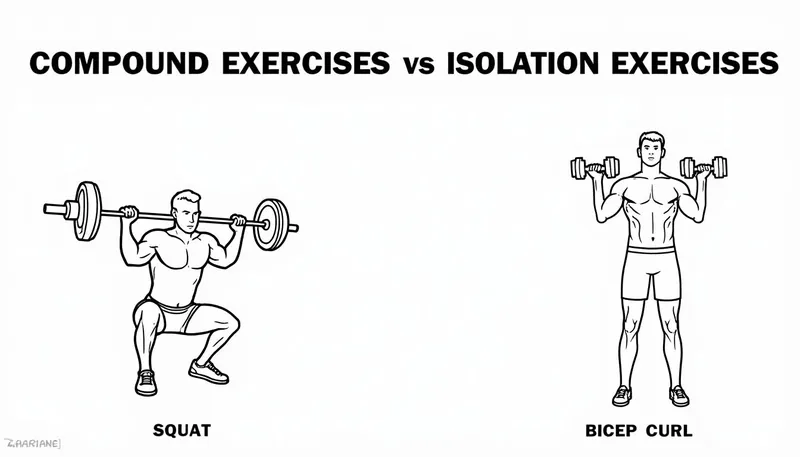In the fitness world, there’s this ongoing debate around compound versus isolation exercises. The reality is, they each bring unique strengths to the table, and recognizing these differences can lead to more effective workout regimes. While compound exercises boast efficiency and major muscle engagement, isolation exercises offer precision for tailored muscle development. Navigating these options in your fitness journey can lead to a more diversified and fruitful training experience.
In Brief:
- ✨ Compound exercises involve multiple joints and muscle groups for efficiency.
- 💪 Isolation exercises focus on single muscles, providing targeted strength.
- 📈 Both types can be integrated for optimal muscle growth and strength development.
- 🏋️♂️ Variety in your workout keeps things fresh and effective.
- 🥦 Nutrition and rest are essential complements to exercise routines.
The Basics of Compound and Isolation Exercises
Let’s kick things off with the fundamental differences. Understanding what defines compound and isolation exercises is vital in crafting a balanced workout. Compound exercises, as the name suggests, are multi-joint movements engaging several muscle groups simultaneously. When you perform a squat, for example, you are not just working your quads; your glutes, hamstrings, and even core muscles are enlisted as well. This holistic engagement is advantageous for those looking for an efficient strength regimen.
On the flip side, isolation exercises target a single muscle group and typically involve just one joint. Take the bicep curl: it’s an exercise that solely focuses on the biceps, allowing for precision training. Being aware of these distinctions is crucial, as they help dictate your routine based on your fitness goals. Here’s a breakdown:
| Type of Exercise | Description | Examples |
|---|---|---|
| Compound Exercises | Engage multiple muscle groups and joints. | Squats, Deadlifts, Bench Press |
| Isolation Exercises | Focus on a single muscle group and joint. | Bicep Curls, Tricep Extensions, Leg Extensions |

Understanding Compound Exercises
When diving deeper, it’s worth noting the advantages of compound exercises. These movements are fantastic for building strength and muscle mass rapidly. They lead to increased calorie burn and promote higher testosterone levels, which can aid in muscle development. Besides just building strength, they also improve overall functional fitness, meaning the strength gained can transfer to everyday activities—like lifting groceries or climbing stairs.
However, with great power comes great responsibility. Compound exercises require proper form and technique to minimize the risk of injury. For instance, a poorly executed deadlift can lead to severe back injuries. It’s therefore essential to start with lighter weights and work up to heavier loads to ensure you master your form. Here’s a list of common compound exercises you might find useful:
- 🏋️♀️ Squats – Excellent for building lower body strength.
- 🏋️♂️ Deadlifts – They engage nearly every muscle in your body.
- 💪 Bench Press – A classic for upper body development.
- 🚴♂️ Pull-Ups – Fantastic for upper body and back strength.
Exploring Isolation Exercises
Isolation exercises play an equally important role in a balanced workout routine. These movements are perfect for targeting specific muscle groups, making them ideal for correcting imbalances or focusing on lagging areas. For instance, if your biceps are less developed compared to your back muscles, adding more bicep curls can help bring symmetry to your physique.
Moreover, isolation movements reduce the risk of injury since they focus on one joint and muscle at a time. This can be particularly useful for recovery and rehabilitation, allowing lighter weight training that facilitates muscle rebuilding without the overall stress of compound lifts.
Here are key benefits of incorporating isolation exercises into your routine:
- 🎯 Targeted muscle development – Perfect for those wanting to enhance specific muscles.
- 🔄 Injury rehabilitation – Great for getting back into the swing without overloading the body.
- 🧘 Low intimidation factor – Ideal for beginners as they can easily control movements.
- 💥 Pre-exhaustion – Can be used to fatigue a muscle before hitting it with a compound movement for improved gains.
The Role of Both Exercises in a Balanced Workout
Inevitably, the question emerges: how do we effectively blend compound and isolation exercises in our training? The answer lies in understanding your fitness goals. If your primary objective is strength gain, then compound exercises should indeed form the backbone of your workout regimen. Things like squats or bench presses should be the main courses of your training meals.
However, if you’re looking to polish your physique or address specific weak points, isolation exercises will come to your rescue. Think of it as creating a symphony: the compound exercises provide the foundation, while isolation exercises add those sweet solos that complete the arrangement.
Also, devising a strategy that incorporates both types of exercises will maximize the results while mitigating the risk of injury. Here’s a sample weekly schedule:
| Day | Workout Focus |
|---|---|
| Monday | Compound Lifts (Squats, Deadlifts) |
| Wednesday | Isolation Exercises (Bicep Curls, Tricep Extensions) |
| Friday | Compound and Isolation Mix |
Incorporating both types of exercises can help you create a more well-rounded and effective training program that not only builds strength and mass but ensures overall muscle balance and functionality.

Nutrition and Recovery: Critical Components for Fitness Success
While understanding exercises is key, it doesn’t overshadow the importance of nutrition and recovery. Nutrition fuels your workouts and recovery ensures that you are repairing your muscles to come back stronger. In 2025, the value of consuming whole foods remains unchanged. Your body needs an array of nutrients to sustain muscle growth and repair.
Complex carbohydrates, lean proteins, and healthy fats are your best friends. Oatmeal, chicken, fish, and colorful salads should headline your meals. Incorporate snacks like almonds and yogurt to keep your energy up throughout your busy days. Here’s a helpful list of foods that you can rely on:
- 🍗 Lean proteins – Chicken, turkey, and fish are great options.
- 🥦 Veggies – Leafy greens and colorful salads for essential nutrients.
- 🍚 Whole grains – Brown rice, quinoa, and oats are solid carb choices.
- 🥜 Healthy fats – Nuts, seeds, and avocados offer healthy energy sources.
Recovery is as vital as the workout itself. After heavy training sessions, muscle repair occurs mainly during rest. So don’t go skipping those rest days! Make sure you are getting adequate sleep and allowing time for recovery between workouts, especially when dealing with intense compound lifts.
Frequently Asked Questions
What’s the main difference between compound and isolation exercises?
Compound exercises involve multiple muscle groups and joints, while isolation exercises target a single muscle or joint.
Which type of exercise is better for muscle gain?
Typically, compound exercises are more effective for overall muscle mass and strength gains. However, isolation exercises also play a crucial role in focused muscle development.
Can I do both types of exercises in one workout?
Absolutely! Combining both types in your routine can optimize results by providing comprehensive muscle engagement.
How many sets and repetitions should I perform?
For compound exercises, focus on 3-5 sets of 1-8 reps for strength, while isolation exercises often suggest 3-4 sets of 8-12 reps for hypertrophy.
Do compound exercises burn more calories?
Yes, because they engage multiple muscle groups, compound exercises tend to burn more calories compared to isolation exercises.


